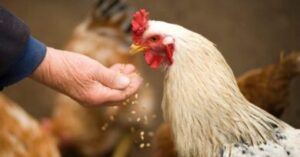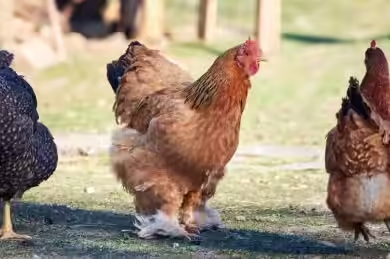Last updated on July 31, 2025
If you’re a poultry farmer, you already know that chicken feed cost calculation is the foundation of your business. Feed is your biggest expense, and understanding how to calculate it for layers, broilers, or any flock size is the first step to improving your profit margin. I learned this the hard way—when a runaway feed bill nearly wiped out my profits.
This guide is your central hub for mastering poultry feed expenses. We’ll cover the universal principles of feed management that apply to any flock. Most importantly, we’ll provide a powerful Poultry Feed Cost & Profit Calculator to do the heavy lifting for you. Whether you’re raising broilers for meat or layers for eggs, this is your starting point for smart, profitable planning.
How Chicken Feed Cost Impacts Your Poultry Profit
When my feed bill shot up by 30%, I realized just how much feed costs can make or break a poultry business. It’s not just my experience—the Food and Agriculture Organization (FAO) confirms that feed is the single biggest expense, often making up 60–70% of total costs.
By implementing a system of tracking, minimizing waste, and choosing the right feed for my flock’s purpose, I was able to boost my farm’s overall profitability by over 20%. The same principles apply whether you’re raising broilers for meat or layers for eggs. The key lesson is this: if you don’t track and optimize your feed cost, you’re leaving money on the table.
Key lesson: If you don’t track and optimize your feed cost, you’re leaving money on the table. Every extra gram wasted is money lost. Every underfed bird is a lost egg or a stunted broiler. Not all chickens eat the same—broilers, layers, and meat birds all have different appetites, and even the same breed eats more or less depending on age, weather, and stress.
Average Feed Consumption: Broilers vs. Layers
The first step in any calculation is knowing the baseline consumption for your type of chicken. Broilers and layers have fundamentally different needs:
- Laying Hens: A mature, producing hen typically eats 110–125 grams of feed per day. Their consumption is relatively stable throughout their laying cycle.
- Broiler Chickens: A broiler’s intake changes dramatically, starting at around 20-25 grams per day and increasing to over 150 grams per day by week six. Their consumption is calculated for the entire batch cycle.
While these numbers provide a baseline, accurate planning requires a detailed, week-by-week breakdown. We’ve created comprehensive guides for each:
- ➡️ For Layers: See our complete guide and feeding charts in How Much Feed for 100 Layers Per Day?
- ➡️ For Broilers: Get a full consumption plan in our Broiler Feed Calculation Guide
Feed Conversion Ratio (FCR) Explained for Beginners
Feed Conversion Ratio (FCR):
FCR = Total Feed Consumed ÷ Total Product (meat or eggs) Produced
- FCR for broilers: 1.5–1.8 (1.5kg feed for 1kg weight gain)
- FCR for layers: 2.0–2.5 (2kg feed for 1kg egg mass)
A lower FCR means your birds are more efficient. Good genetics, quality feed, and proper management all help improve FCR. Source: University of Georgia Extension
Best Way to Reduce Chicken Feed Waste and Save Money
- Use anti-spill feeders or tube feeders.
- Raise feeders to back height.
- Don’t overfill feeders—two-thirds full is enough.
- Store feed in airtight bins to prevent spoilage and pests.
- Track feed intake and adjust for weather, age, and breed.
For more tips, see 15 Simple Secrets to Raising Happy, Healthy Chickens.
Advanced Strategies for Reducing Feed Cost
- Bulk Buying and Cooperatives: Join a local group to get better prices.
- Direct from the Mill: Cut out the middleman and save up to 10% per bag.
- Seasonal Buying: Buy extra feed before the rainy season, when prices spike.
- Local Ingredients: Supplement with local grains (like maize or sorghum) only after consulting a poultry nutritionist.
- Use a Calculator: Try the Poultry Feed Cost & Profit Calculator to plan and track your costs.
Regional Realities: Nigeria vs. Other Markets
Feed prices and availability can change fast, especially in Nigeria. Inflation, currency changes, and transport costs all play a role. In early 2025, prices for a 50kg bag ranged from ₦38,000 to ₦56,000 depending on type and brand. Always check local prices and be ready to adjust your budget.
Poultry Feed Cost & Profit Calculator
Instantly Estimate Your Feed Needs and Profit
Use the calculator below to estimate your feed requirements, costs, and potential profits for your flock. Just enter your numbers and get instant results.
Poultry Feed Cost & Profit Calculator
Master your farm’s profitability by accurately estimating feed consumption, costs, and potential revenue for different chicken types.
Your Flock Details
Percentage of birds expected to be lost during the period.
This selection will pre-fill the average daily feed intake.
Adjust this value if you have specific breed data or observations.
Account for spillage, pests, etc. (e.g., 5% is common).
Laying Hen Specifics
Enter as a decimal (e.g., 0.9 for 90% production).
Broiler/Meat Chicken Specifics
Enter the average weight you sell your birds at.
Price per unit (kg or lb) you sell the meat for.
Total feed consumed by one bird from chick to market weight (e.g., 4kg for 6-week broiler).
Total number of days for the entire batch to reach market weight.
Your Feed Bag Details
Your Estimated Results
Laying Hen Profitability (Monthly)
Broiler/Meat Chicken Profitability (Per Batch)
These calculations provide a solid foundation. Remember to account for other operational costs, mortality, and market fluctuations for true profitability.
Frequently Asked Questions About Chicken Feed Costs: Your Burning Questions Answered!
How many bags do I need for 100 layers per month?
About 7–8 bags of 50kg feed, depending on intake and waste.
How do I reduce feed costs?
Track everything, use anti-spill feeders, buy in bulk, and store feed properly.
What is the best way to reduce chicken feed costs?
The most effective methods are minimizing waste with proper feeders, buying feed in bulk to get better pricing, ensuring your flock is healthy, and storing feed correctly to prevent spoilage.
How does environmental temperature affect feed consumption?
Temperature has a major impact. In cold weather, chickens eat more to generate body heat. In hot weather, their appetite decreases, which can slow down growth or egg production if not managed properly.
Is making homemade chicken feed cheaper?
It can be, but it’s risky for beginners. Commercial feeds are scientifically formulated to provide balanced nutrition. An imbalanced homemade feed can lead to poor health and lower production, costing you more in the long run.
What is a good Feed Conversion Ratio (FCR)?
A lower FCR is always better. For broilers, a good FCR is between 1.5 and 1.8. For layers, it’s typically between 2.0 and 2.5 (measured as kg of feed per kg of eggs).
How many bags of feed do 100 layers need per month?
A well-managed flock of 100 layers typically requires 11-12 bags of feed per month. For a complete breakdown and feeding chart, see our detailed guide on layer feed consumption.
Wrapping It Up: Your Path to Poultry Profitability!
We’ve journeyed from the basics of how to calculate chicken feed cost to advanced strategies for optimizing farm profitability. Remember, managing your poultry feed cost isn’t just about cutting corners; it’s about smart planning, efficient practices, and leveraging the right tools.
By understanding your birds’ needs, meticulously tracking consumption, and staying savvy about market dynamics, you’re not just feeding chickens; you’re building a more resilient and profitable farming business. It’s a journey, not a destination; every step you take towards better feed management adds to your success.
What are your biggest challenges when it comes to managing feed costs? Or perhaps you have a unique tip you’d like to share? Drop a comment below! I’d love to hear your insights and continue this conversation. Let’s keep those chickens happy and those profits soaring!
More Related Post for Deeper Learning
- How Many Eggs Will Your Chickens Lay?
- Chicken Feed for Egg Production
- 15 Simple Secrets to Raising Happy, Healthy Chickens
- Can You Really Make Money with Poultry Chicken Farming in South Africa?
- 9 Powerful Advantages of Raising Dual Purpose Noiler Chickens
- 7 Ways to Boost Profitability in Your Noiler Chicken Farm
Sources & Further Reading
- FAO: Poultry feed availability and nutrition
- University of Georgia: Commercial Layer Production Guide
- Poultry Feed Cost & Profit Calculator (Nigeria)
- How Many Crates of Eggs Can 1000 Layers Produce? Profit Guide
Try It Yourself (And Share Your Results!)
If you’re serious about making your poultry farm more profitable, start tracking your feed today. Use the calculator, try my tips, and see how much you can save. Got a question or a tip of your own? Drop a comment below—I’d love to hear what’s working for you!
Want to know how much profit you can make from your eggs?
Check out: How Many Crates of Eggs Can 1000 Layers Produce? Profit Guide


